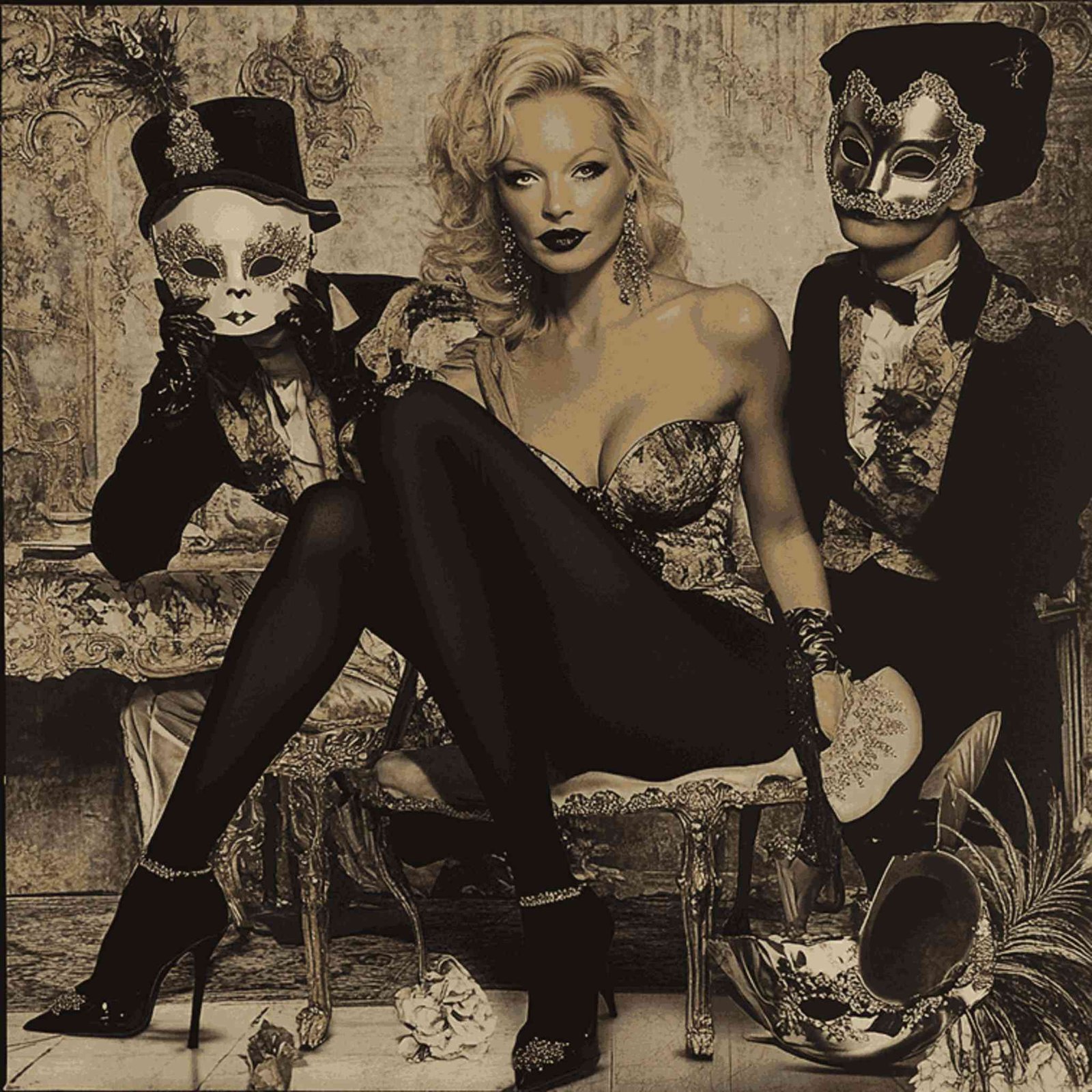Description
Exhibition Introduction and Art Critique: “Agnus Dei AZ14”
Stepping into Agnus Dei AZ14, we encounter a scene that is both captivating and disquieting. The elegantly attired couple, masked and poised, evokes the intrigue of Venetian masquerades, where hidden desires mingle with social performance. Yet beneath this glamour lies an unsettling tension, prompting us to explore the intricate dynamics of identity, power, and vulnerability.
The woman, seated in a plush armchair, commands attention. Her luxurious outfit—fishnet stockings, red high heels, and a lace corset—blends eroticism with an air of authority. While her gaze is concealed, her body language exudes confidence and intentionality. Her partner, adorned in a formal tuxedo and a mask, gently rests his gloved hand on her arm, symbolizing distance and ritual, suggesting complex power dynamics. Together, they pose questions about their relationship and the roles they embody in this charged moment.
The title Agnus Dei—Latin for “Lamb of God”—introduces themes of sacrifice and redemption. AZAD invites viewers to consider the roles of predator and prey within this intimate tableau. The contrast between the sacred connotations of the title and the scene’s sensuality heightens the tension between innocence and lust, complicating our understanding of purity.
Drawing comparisons to 20th-century erotic photography, such as the works of Helmut Newton, Guy Bourdin, and Nobuyoshi Araki, Agnus Dei AZ14 similarly explores themes of power and objectification. AZAD’s use of masks deepens this exploration, reminding us of the layers of identity we all navigate, concealing our innermost fears and desires.
Influence, Meaning, and Message: Layers of Desire and Power
At the heart of Agnus Dei AZ14 lies the motif of the mask, which serves both to conceal and to transform. The intricately designed masks worn by the couple create new identities, enabling them to adopt roles shaped by societal expectations and the dynamics of desire. This duality allows for a rich exploration of the masks we wear in life—the personas we craft in our interactions and the expectations we navigate.
The woman’s delicate, lace mask accentuates her beauty while simultaneously obscuring her true emotions. In contrast, her partner’s darker mask suggests control and authority, yet the presence of white gloves introduces ambiguity. Is he genuinely in control, or is he merely playing a role of servitude in this intricate dance of power?
AZAD’s work often grapples with the tension between materialism and deeper existential inquiries. The luxurious setting—the opulent armchair, the richly textured room—highlights the allure of wealth and desire while prompting reflection on authenticity. Are we witnessing genuine intimacy, or merely another performance within the grand theater of life?
This theme resonates with the legacies of Newton and Bourdin, who similarly examined the interplay between the erotic and the theatrical. AZAD’s figures, while alluring, remain enigmatic, trapped within their masks and roles, ultimately prompting us to consider the authenticity of their interactions.
The Technique: A Masterpiece of Digital Artistry
In Agnus Dei AZ14, AZAD demonstrates his mastery of mixed media on canvas, merging traditional artistry with cutting-edge digital techniques. The textured canvas adds depth, while the hyperreal quality of the figures engages the viewer on multiple levels. The interplay of soft fabrics against the flawless skin of the figures creates a palpable tension, inviting exploration of the scene’s intricate details.
The play of light and shadow enhances the intimate atmosphere. The warm illumination surrounding the couple evokes a sense of closeness, while shadows add layers of mystery. AZAD renders the intricate details—the masks, lace, and gleaming heels—with precision, making them appear almost tangible, beckoning the viewer to engage.
The composition is carefully crafted, with the couple positioned centrally, their bodies angled toward each other, suggesting intimacy and distance. The rich color palette—deep reds, blacks, and golds—contributes to the sense of opulence, while the textured background enhances depth. AZAD’s blending of traditional techniques with digital innovation results in a piece that is both visually stunning and emotionally compelling.
AZAD 777781: The Visionary Behind the Canvas
Understanding Agnus Dei AZ14 requires insight into its creator, AZAD 777781, a digital artist acclaimed for his exploration of human psychology. His work delves into themes of fear, desire, obsession, and power, reflecting the complexities of existence in a constantly shifting world.
Rooted in figurative expressionism, AZAD’s style allows for the exploration of deep emotions through the human form. His figures often convey tension and introspection, embodying the weight of their inner lives. This psychological depth is married to a sense of elegance, utilizing light and texture to create beauty and emotional resonance.
AZAD stands apart by pushing the boundaries of digital and traditional media. In Agnus Dei AZ14, he harmonizes the precision of technology with the warmth of painting, exploring identity through the recurring motif of masks. This blend invites viewers to engage with the underlying questions of power and authenticity.
A Poetic Meditation on Greed, Passion, and Philosophy
At its core, Agnus Dei AZ14 serves as a meditation on fundamental aspects of human experience: greed, passion, and the interplay between materialism and spiritual truth. The luxurious setting and elaborate attire underscore the allure of desire, yet prompt a deeper inquiry: What is real versus performance?
The masks worn by the figures symbolize the roles we play, concealing our true selves beneath layers of artifice. The woman’s delicate mask emphasizes femininity, while her partner’s darker mask suggests dominance. Together, they evoke questions about authenticity—are we witnessing genuine intimacy, or merely a performance in life’s grand theater?
This theme resonates throughout AZAD’s work, challenging viewers to confront the masks they wear and the identities they construct. In Agnus Dei AZ14, the figures engage in a masquerade, suggesting that their true selves remain hidden behind layers of societal expectations.
Innovation and Imagination: Pushing the Boundaries of Art
AZAD’s artistry exemplifies the potential of art to challenge conventions. Through mixed media, he crafts a piece that resonates with both timeless and contemporary elements, reflecting human experiences within a materialistic context. The figures in Agnus Dei AZ14 invite viewers to engage with deeper philosophical inquiries.
By blending traditional and digital techniques, AZAD achieves a visual and emotional richness that captivates audiences. The masks, opulent setting, and elaborate attire symbolize societal roles, while inviting reflection on the complexities of identity and authenticity. Beneath this lavish surface, AZAD suggests that the figures are ensnared in their performances, unable to reveal their true selves.
AZAD’s innovation and imagination establish him as a leading voice in contemporary art, reminding us that art transcends mere representation, offering a lens through which to explore our hidden truths and desires.
Conclusion: A Masterpiece of Visual and Emotional Tension
Agnus Dei AZ14 is a tour de force of visual and emotional tension, a portrayal of identity, power, and desire that encapsulates the human experience’s complexities. Through his innovative approach, AZAD 777781 invites viewers to question their roles in life’s performances while appreciating the beauty of the composition.
As we engage with these masked figures, we are reminded of our own masks, the ways we navigate the intricate dynamics of human relationships. Agnus Dei AZ14 inspires and challenges us, a testament to AZAD’s ability to capture the essence of humanity in an era defined by appearances and artifice.





